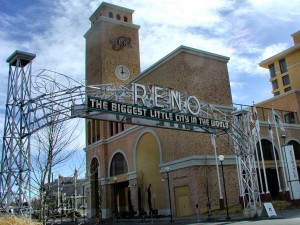
Photo by Bob Harmon
Scott Sonner of the Associated Press has written a nice piece on Reno’s historic 1905 Virginia Street Bridge, soon to be demolished. I was glad to be able to share with him my thoughts about its significance to the city and beyond. You can read the story here.
Early one morning a few weeks ago, I stood on the bridge with three amazing women who devoted years to the effort to integrate preservation of the bridge into plans for the future of downtown Reno. I joined those efforts soon after I moved to town in 2003, inspired by the bridge’s understated elegance and classical form, its centrality to Reno’s development and identity, and the multitude of stories it contains.
Together, we worked for years in pursuit of a solution that would allow the bridge to remain in place while still accommodating the needs of flood control and the concerns of downtown business owners, and it is important that we did that. It is right and good for us to make every attempt to combine development with preservation of our most historic structures. It is critical for us to ask questions and to engage in those difficult conversations, sharing our opinions in a public forum. We should continue to do that as a city. We owe it to our past, recognizing that the future we are building will be infinitely enriched by embracing the stories of who and what we have been. The loss of each historic structure deprives us of a tangible reminder of our heritage, making it that much more difficult to connect to what came before us.

I’m proud of how hard we worked to save the bridge. And when it was clear that this bridge could not accommodate the level of flood protection required by the City of Reno, the Army Corps of Engineers, business owners, and the Truckee River Flood Project, I’m proud that each and every one of us who stood on the bridge that day participated in the process of determining what would replace it. We attended meetings of the Design Review Board convened to select a new bridge design, we met with its architects and engineers, and we discussed how to incorporate elements of the historic bridge into the new span. It is impossible to be a dedicated historic preservationist, at least a successful one, without also being a clear-eyed realist.
On that day, our final day on the bridge together, we talked about how much it had seen in its 110 years: the growth of the city’s population from fewer than 10,000 residents to more than 250,000; the devastating fires that brought down earlier versions of the Riverside Hotel and the Masonic Temple; the demolition of the charming little Carnegie Library to make way for the Post Office building now gracing the south bank; the golden peals of laughter and music cascading from the Mapes and Riverside in their prime; the hum of the streetcar traversing its length; and yes, the footsteps of the newly divorced, pausing for a moment at the railing to consider whether or not to join the ranks of the famed ring-flingers.
We brought with us armfuls of white roses and daisies, and flung them one by one, like discarded wedding rings, into the river, watching them land gently in the rivulets and catch in the rocks, until they finally broke free, winding their way downstream and out of sight.
Goodbye to a bridge that has served this city so well. Goodbye to your beauty and elegance, to your steadfast endurance through times both robust and lean. Goodbye to a well-worn path trod by thousands. Goodbye to the rings and flowers, to the crystalline blue of that morning sky. Goodbye, goodbye, goodbye.

Photo courtesy of Special Collections Department, University of Nevada, Reno Libraries







